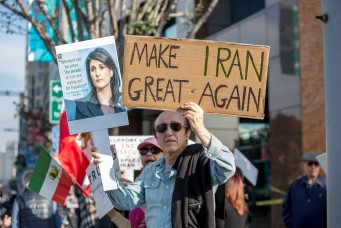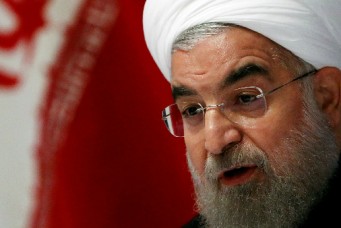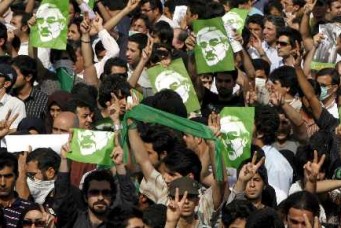Is Theocratic Rule in Iran Coming to an End?
With every wave of protest over the past few years comes mounting expectations that the Islamic rule in Iran will come to an end.

A woman takes part in a protest against the Islamic regime of Iran following the death of Mahsa Amini, in Istanbul, Dec. 10, 2022. Dilara Senkaya/Reuters
Iran has always been the focus of international attention since the 1979 Islamic Revolution. The reasons are many: the Islamic Revolution is arguably considered as one of the world’s greatest revolutions. It not only produced major social structural changes in Iranian society, but like all great revolutions it has had major worldwide implications, particularly in the Middle East region. Putting aside the very important doctrinal differences between Sunni and Shia Islam, the Iranian Revolution gave impetus to the “conceptual project” of political Islam by producing for the first time a republican theocratic regime in the region.
To protect the revolution, Tehran opted for a “forward defense strategy” by pursuing policies designed to ensure that governments in the region were not hostile to it. The strategy entails that Iran should fight its opponents outside its borders to prevent conflict inside the country. It has also pursued a nuclear weapon capability to deter its adversaries in the region and beyond. The result was that it jeopardized its relations with many of its Arab neighbors. But also to brandish its revolutionary credentials and gain the support of Muslims around the world, Tehran adopted a hostile attitude toward Israel. As a result it was considered by the United States a rogue state inimical to its interests.
As a consequence most Arab countries, the United States as well as others, pursued policies designed to force Tehran, at a minimum to alter its policies, and at a maximum to bring about regime change.
With the most recent protests, which resulted in the death of 22-year-old Masha Amini while in custody of the “morality police” in September, 2022 and subsequent protests, expectations of regime change have vigorously surfaced once again. Hopes have been generated once again among regime dissidents in Tehran, and detractors of the Islamic Republic abroad, that the protests will be a harbinger for regime change. So far, they have been disappointed.
Although many experts on Iran on both sides of the political spectrum are of the view that the protests will not produce a different political outcome, some change is visible. For example, adherence to the hijab or the headcover is no longer strictly enforced. Moreover, the fate of the morality police has also been put in question as the Prosecutor General released a statement that it has been disbanded.
Despite these changes, the recent protests may well disappoint many across the world who continue to hope that Iran’s theocratic rule might be coming to an end soon. That may be true in the short term. However, the medium to long-term prospects of change in Iran may be different.
Currently there are a number of factors that may influence the future course of Iranian politics and the possible unravelling of theocratic rule in Iran. If, when, and how change occurs remains in the province of guesswork. These factors include:
First, a debate has emerged amongst the clergy in Qom about the survival of the doctrine of Vilayet Al Faqih as developed by Ayatollah Khomeini, which entails that a Guardian Jurist “the Faqih” or the supreme leader is at the center of political power. If the doctrine is abolished after Ayatollah Khamenei’s death, this could signal the beginning of the unravelling of the theocratic rule in Iran.
Second, with Ayatollah Khameini advancing in age and in poor health, the focus is on who would succeed him. The fact that there is no designated or apparent successor opens the door to a number of possible scenarios. Among these scenarios are: (1) a Collegiate leadership comprised of at least three prominent members of the clergy; (2) a ceremonial role for the Supreme Leader position, which apparently is the preferred choice of the Revolutionary Guard as it allows them to further enhance their political influence; and (3) the selection of a compromise candidate that is not necessarily the most qualified. If this were to happen, Ayatollah Khamenei could very well be succeeded by weaker candidates, thereby opening the door of undermining the institution of Vilayet Al Faqih and ultimately the hold of the clergy over political power.
Third, as a consequence of a series of failures by the Revolutionary Guard—mostly in the field of counter-intelligence resulting in their inability to prevent Israeli operations inside Iran and which resulted in changes amongst the senior ranks of the Revolutionary Guards—the role of the Revolutionary Guard is apparently being revisited. How will these changes affect the future role and influence of the Revolutionary Guard is a matter that merits scrutiny.
Fourth, there appears to be mounting disillusionment among conservatives in the country. Those have been the main supporters of the Islamic Revolution, but have never agreed among themselves on to how the Islamic state should look like. But now there is a measure of disappointment among some of them toward those who hold the reins of power, particularly when it comes to the Iranian foreign policy. There are serious reservations about Tehran’s regional policies that have diverted resources away from building a better and more efficient Islamic state. This is an important constituency that if lost may effect a measure of change.
Fifth, with the protests this time round, although initially erupting in the Kurdish areas of the country, they spread around the country, but particularly in Baluchistan where the government resorted to heavy-handed tactics resulting in a considerable loss of life. The different ethnic groups in Iran (which account for some 40 percent of the population) seized upon the protests to air their long-held grievances against the ruling theocracy in Tehran. While all these ethnic groups have been part of the Iranian nation for centuries, simultaneous unrest amongst them is destabilizing and may weaken the grip of the central authorities in Tehran.
Sixth, the generational gap between the two generations that made the revolution possible, and those who have been born after 1979 and have no recollection of either the pre-revolutionary period or the early years of the revolution and therefore have a rather tenuous attachment to the Islamic State, has resulted in widely different expectations about the future of Iran. Suffice to note that 67 percent of the population are under the age of 40, and half of them are under the age of 24. It is the latter group that form the bulk of the protesters.
How these factors will develop and engage with one another to create a situation that would trigger change, whether gradual or abrupt, in the nature of the ruling regime in Tehran remains an open question.




